When winter arrives, many people think of cozy firesides and staying indoors, but for outdoor enthusiasts, it’s a season that reveals a whole new side of nature. The winter months transform many of our national parks into breathtaking wonderlands, offering unique experiences, fewer crowds, and serene landscapes draped in snow or bathed in soft winter light. From snow-covered mountains to frost-kissed forests, these parks invite visitors to explore a world of winter activities like snowshoeing, skiing, wildlife watching, and more. In this post, we’ve compiled the top 10 national parks to visit this winter, each offering its own magical scenery and seasonal adventures. Whether you’re craving the quiet beauty of snow-dusted peaks or the warm winter sun of milder climates, these parks are perfect for discovering the beauty of the season.
1. Yellowstone National Park
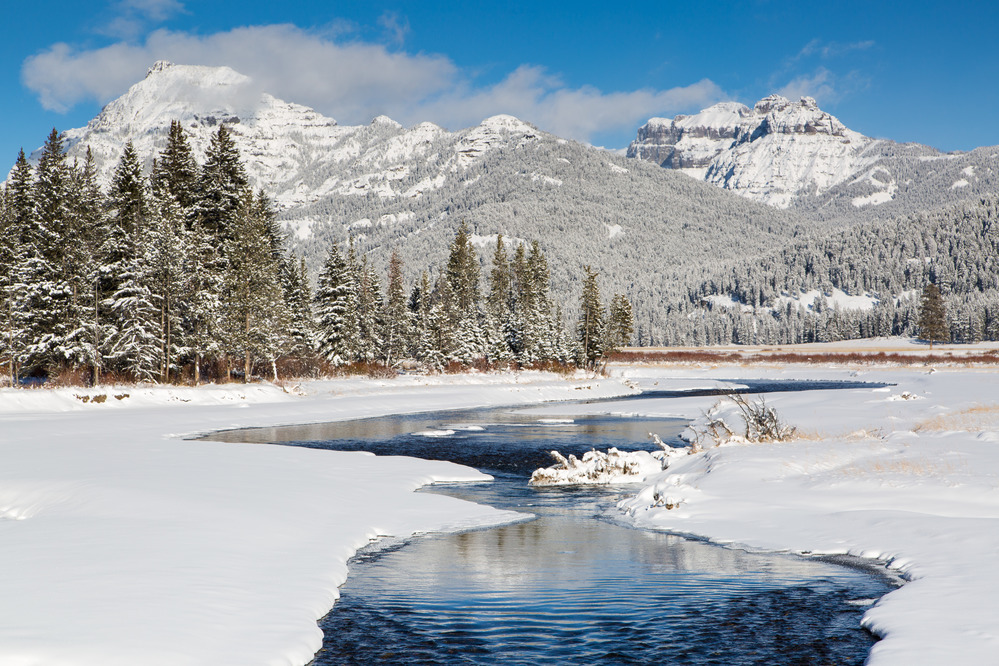
Yellowstone National Park, located primarily in northwestern Wyoming, though extending into Montana and Idaho, is best known for its stunning geothermal features, including the famous Old Faithful geyser, colorful hot springs, and vast volcanic landscapes. Established in 1872, Yellowstone was the first national park in the world and is renowned for its diverse ecosystems, which support a wide range of wildlife, including bison, elk wolves, and grizzly bears. The park’s unique geology is highlighted by the Yellowstone Caldera, a supervolcano that has shaped the region over millions of years, creating breathtaking sights like the Grand Prismatic Spring and Mammoth Hot Springs. Visitors can explore over 900 miles of hiking trails, scenic drives, and a network of boardwalks that lead to its most famous geothermal features. With its awe-inspiring landscapes and rich natural history, Yellowstone National Park offers a captivating experience for outdoor enthusiasts and nature lovers alike.
Winter in Yellowstone (December-February)
- Snow-Covered Landscapes and Peaceful Winter Scenery: Winter transforms Yellowstone into a serene, snow-covered wonderland. Snow blankets the geysers, meadows, and trees, creating a magical landscape that feels like stepping into a different world. The quiet, snowy setting is perfect for peaceful exploration and photography.
- Winter Recreation and Snow Sports: Winter is ideal for snowshoeing, cross-country skiing, and guided snowmobile tours. The park’s groomed trails and designated areas allow visitors to explore the winter scenery safely, with ranger-led snowshoe walks offering insights into the park’s winter ecology.
- Fewer Visitors and a Solitary Experience: Winter is Yellowstone’s least crowded season, making it perfect for those seeking solitude. Iconic spots like Old Faithful and Mammoth Hot Springs can be enjoyed in near solitude, allowing for a deeper connection with the park’s beauty.
- Unique Geothermal Sightings in the Cold: Winter’s cold air enhances the visibility of steam rising from Yellowstone’s geysers, hot springs, and fumaroles. The contrast of the steaming geothermal features against the snowy landscape creates stunning scenes that can only be witnessed in winter.
2. Yosemite National Park
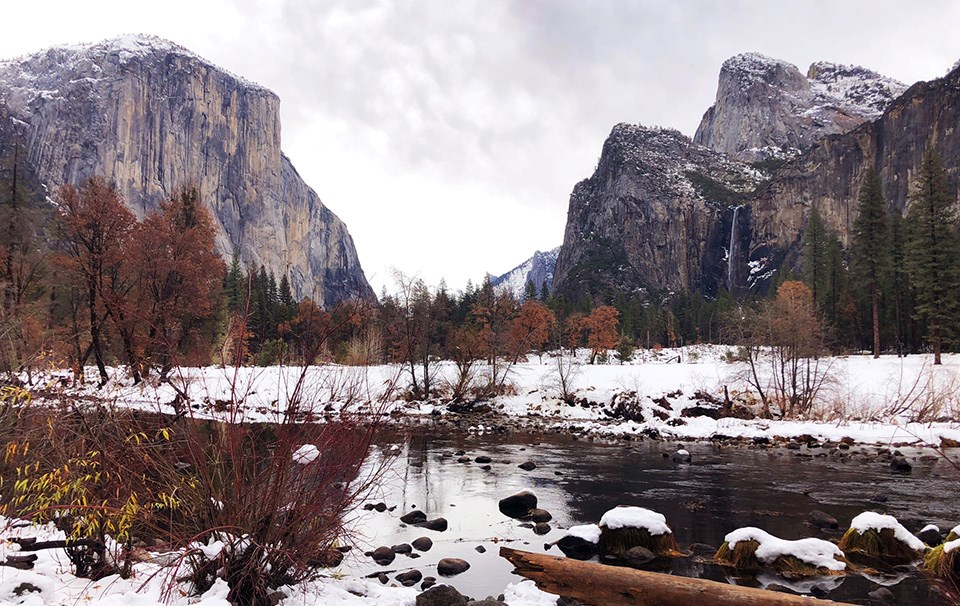
Yosemite National Park, located in California’s Sierra Nevada mountains, is best known for its spectacular granite cliffs, stunning waterfalls, and ancient sequoia groves. Its iconic landmarks, such as Half Dome, El Capitan, and Yosemite Falls—the tallest waterfall in North America—make it one of the most famous national parks in the world. Established in 1890, Yosemite encompasses nearly 1,200 square miles of diverse landscapes, including deep valleys, expansive meadows, and high mountain peaks. The park’s picturesque Yosemite Valley draws millions of visitors each year to marvel at its breathtaking views and engage in activities like hiking, rock climbing, and photography. Beyond the valley, the park offers serene trails in Tuolumne Meadows, spectacular vistas from Glacier Point, and peaceful groves of giant sequoias in Mariposa Grove. With its unparalleled natural beauty, diverse ecosystems, and wealth of recreational opportunities, Yosemite National Park is a true crown jewel of America’s national park system.
Winter in Yosemite (December-February)
- Snow-Covered Landscape and Winter Wonderland: Winter transforms Yosemite into a serene, snow-covered wonderland. Snow blankets the granite cliffs, meadows, and trees, creating stunning scenery for photography. The sight of Yosemite Falls and Half Dome under snow adds a magical quality to the park.
- Winter Recreation: Winter activities like snowshoeing, cross-country skiing, and ice skating are popular in Yosemite. The park’s Badger Pass Ski Area offers downhill skiing, snowboarding, and tubing, making it a great winter destination for those seeking outdoor fun.
- Quiet Trails and Fewer Visitors: Winter is the least crowded season in Yosemite, offering peaceful exploration of iconic spots like Yosemite Valley and Mariposa Grove without the typical crowds. The quiet and tranquility of the snowy landscape allow for a more reflective and intimate experience with nature.
- Stunning Views and Crisp Air: Winter’s clear, crisp air enhances visibility, making for spectacular views of the granite cliffs, valleys, and waterfalls. This season is perfect for scenic drives and photography, with the winter light casting a unique glow over the snow-dusted landscapes.
3. Bryce Canyon National Park
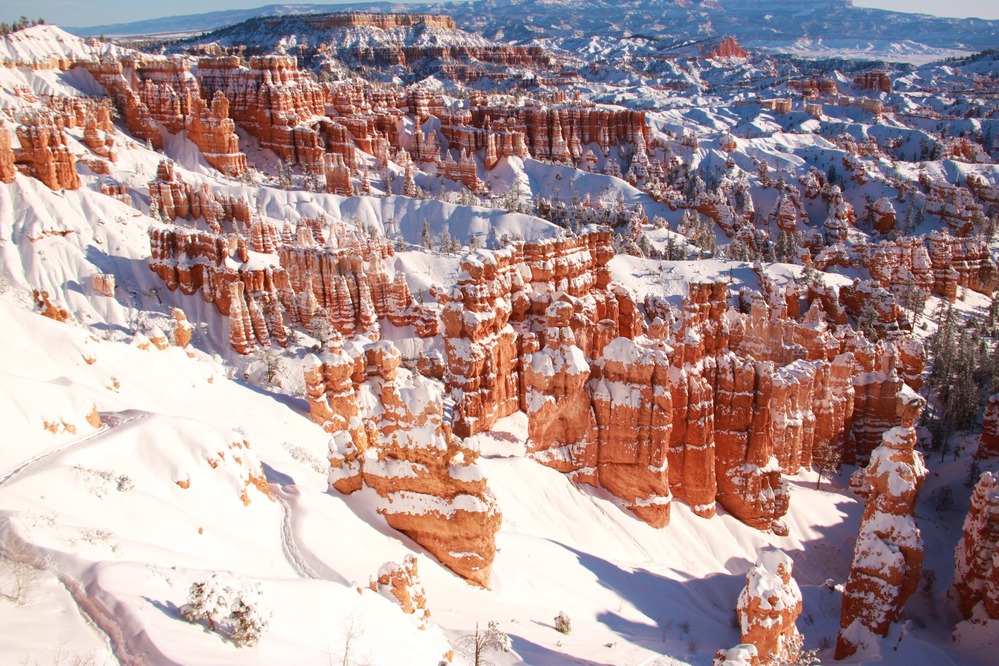
Bryce Canyon National Park, located in southern Utah, is best known for its extraordinary amphitheaters filled with unique rock formations called hoodoos—towering spires of red, orange, and white rock carved by erosion. The park’s largest amphitheater, Bryce Amphitheater, stretches over three miles and provides panoramic views of these surreal landscapes, which are particularly stunning at sunrise and sunset when the colors shift in the changing light. Trails like the Navajo Loop and Queen’s Garden Trail allow visitors to walk among the hoodoos and experience the landscape up close, while viewpoints like Sunrise Point and Inspiration Point offer breathtaking perspectives from above. Bryce Canyon’s high elevation provides cool summer temperatures and excellent night sky visibility, making it one of the best stargazing locations in the national park system. Known for its ethereal beauty and distinctive rock formations, Bryce Canyon National Park offers a remarkable and otherworldly experience in the scenic red rock country of the American Southwest.
Winter in Bryce Canyon (December-February)
- Snow-Covered Hoodoos and Unique Winter Scenery: Winter transforms Bryce Canyon into a magical, snow-dusted landscape, with snow blanketing the hoodoos and red rock formations. The contrast of white snow against the red and orange rocks creates a stunning and unique sight, making winter one of the most beautiful seasons for photography.
- Fewer Visitors and Solitary Trails: Winter is the least crowded season, perfect for those seeking solitude and a peaceful experience. Visitors can explore popular trails, overlooks, and viewpoints without the crowds, providing an intimate and tranquil experience of the park’s dramatic scenery.
- Snowshoeing and Cross-Country Skiing: Winter recreation is popular at Bryce Canyon, with designated trails for snowshoeing and cross-country skiing. The park offers ranger-led snowshoe walks, allowing visitors to explore the winter landscape while learning about the park’s geology and ecosystem.
- Clear Skies and Exceptional Stargazing: Winter’s clear, crisp air enhances stargazing conditions, offering excellent visibility of stars, constellations, and the Milky Way. The long nights provide more time for nighttime observation, and the park’s remote location allows for breathtaking views of the winter sky.
4. Rocky Mountain National Park
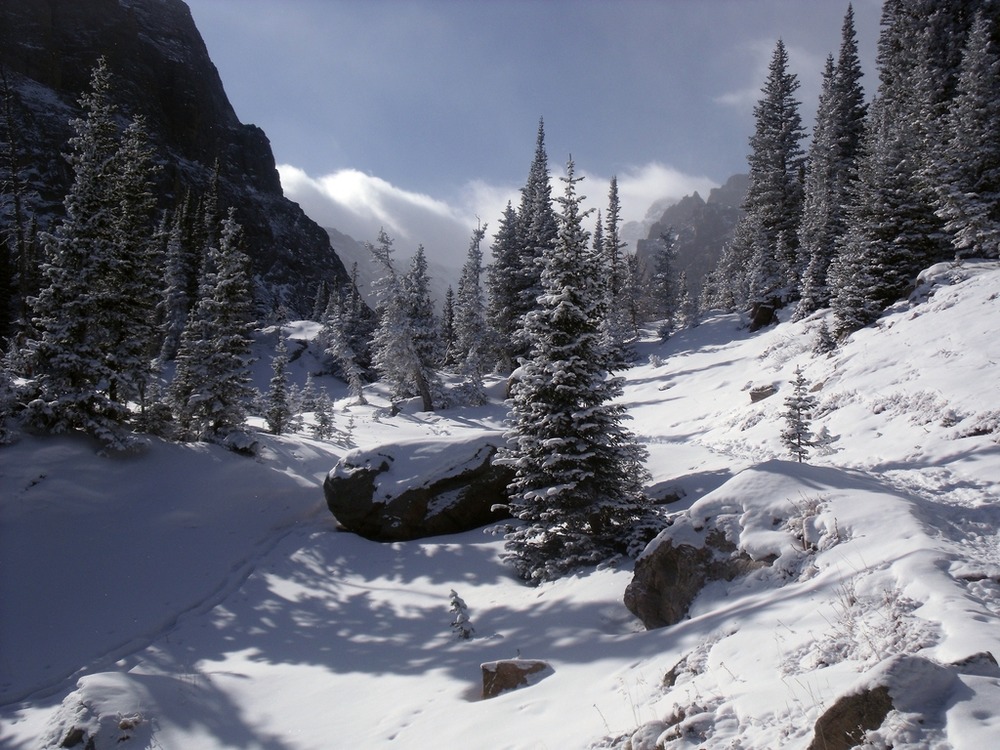
Rocky Mountain National Park, located in northern Colorado near Estes Park, is best known for its stunning alpine scenery, majestic mountain peaks, and diverse wildlife. The park spans over 415 square miles and includes some of the most iconic landscapes of the Rocky Mountains, with elevations ranging from 7,860 to over 14,000 feet at Longs Peak. Known for its breathtaking Trail Ridge Road, the highest continuous paved road in North America, the park provides panoramic views of mountain ranges, glacial valleys, and alpine tundra. Visitors flock to popular spots like Bear Lake, Emerald Lake, and the Continental Divide, which offer some of the most scenic hiking and photography opportunities in the country. The park is also a wildlife haven, home to elk, moose, bighorn sheep, and black bears, making it a favorite destination for wildlife enthusiasts. With its rugged beauty, numerous trails, and dramatic mountain landscapes, Rocky Mountain National Park offers an unparalleled experience of Colorado’s high-altitude wilderness.
Winter in the Rockies (December-February)
- Snow-Covered Landscape and Winter Wonderland: Winter blankets the park in snow, creating a serene, magical atmosphere with snow-covered trees, frozen lakes, and stunning mountain vistas. The snowy landscape offers a unique perspective on Rocky Mountain National Park’s beauty, making it perfect for winter photography.
- Winter Recreation: Winter brings excellent opportunities for snowshoeing, cross-country skiing, and sledding. Trail Ridge Road may be closed, but many trails remain open for winter recreation, including popular routes like Bear Lake and Sprague Lake, which are transformed into peaceful winter landscapes.
- Fewer Crowds and Quiet Trails: Winter is the least crowded season, providing a peaceful and quiet experience for visitors seeking solitude. The lack of summer crowds allows for intimate exploration of the park, and the snow-covered trails and viewpoints create a truly tranquil environment.
- Stargazing and Clear Night Skies: The crisp winter air enhances visibility for stargazing, making it an ideal season for observing the night sky. The park’s dark skies reveal stunning views of stars, constellations, and occasionally the Milky Way, creating a beautiful experience for nighttime visitors.
5. Grand Canyon National Park
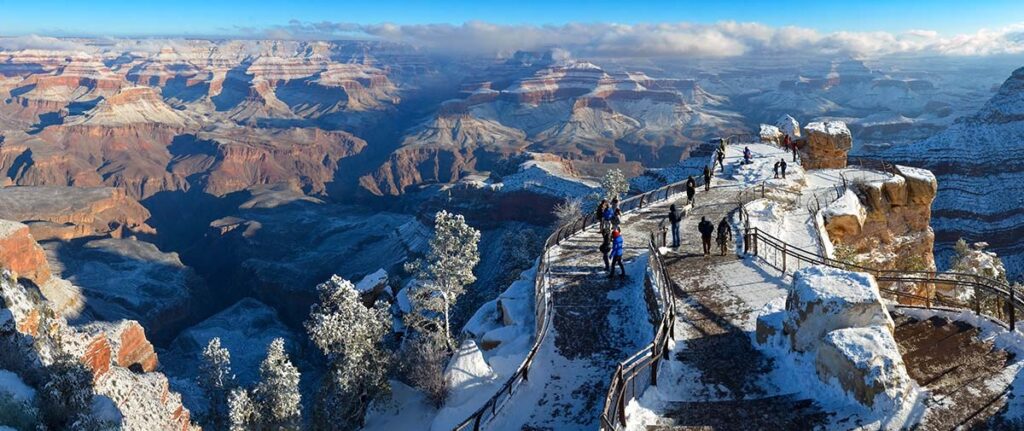
Grand Canyon National Park, located in northern Arizona, is best known for its iconic, immense canyon carved over millions of years by the Colorado River. This natural wonder stretches 277 miles in length, up to 18 miles in width, and plunges over a mile deep, revealing stunning layers of colorful rock that tell a geological story spanning nearly two billion years. Visitors come from around the world to marvel at its
vastness, explore its rugged trails, and take in breathtaking views from popular spots like the South Rim, Bright Angel Point, and Desert View. The park also offers adventurous hiking and rafting experiences, including the challenging descent to the canyon floor and whitewater rafting trips through the Colorado River. A UNESCO World Heritage Site, Grand Canyon National Park is accessible by car, with the South Rim open year-round, providing a truly unforgettable experience of one of the world’s most magnificent natural landscapes.
Winter in Grand Canyon (December-February)
- Peaceful Solitude: Winter is the least crowded season in the Grand Canyon, allowing visitors to experience its grandeur in near silence. The quiet, peaceful atmosphere is ideal for those looking to connect deeply with nature and take in the views without the bustling crowds.
- Stunning Snow-Covered Views: Winter snowfall dusts the canyon’s cliffs and rock formations with a light layer of snow, creating breathtaking contrasts with the red and orange hues of the canyon walls. This winter scenery provides a rare and strikingly beautiful perspective on the Grand Canyon.
- Mild Temperatures on the South Rim: Although winter nights are cold, daytime temperatures on the South Rim remain relatively mild, often ranging between 40-50°F (4-10°C). Winter hikers can enjoy the cooler weather without worrying about summer’s intense heat.
- Discounted Rates and Greater Availability: Winter is off-peak season, which means lodging and tour rates are often lower, and more accommodations are available. This makes it an economical time to visit for those looking to experience the canyon on a budget.
6. Zion National Park
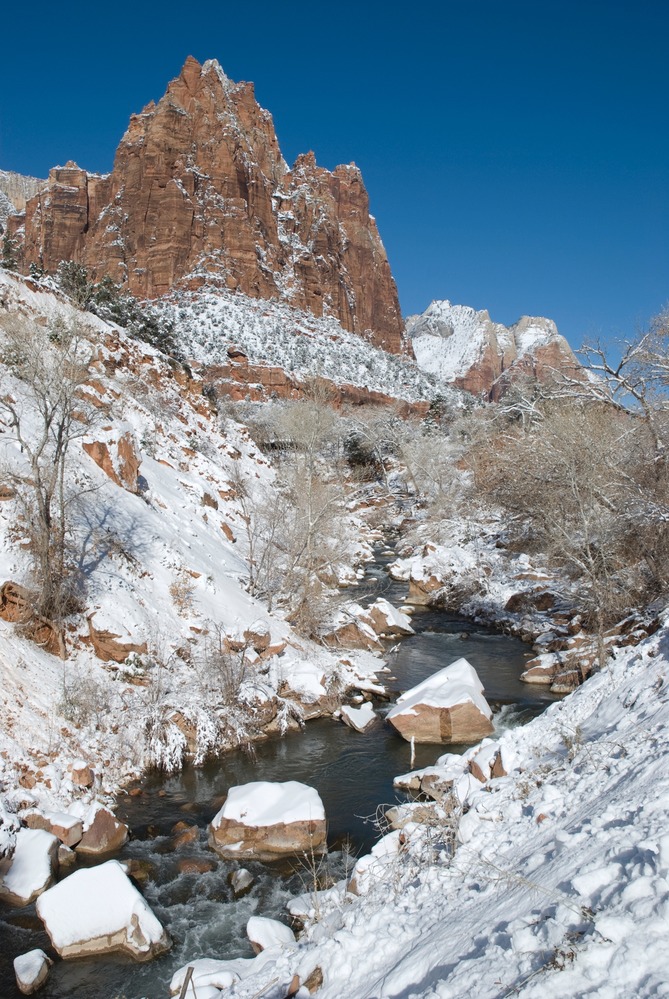
Zion National Park, located in southwestern Utah near the town of Springdale, is best known for its stunning red rock formations, dramatic canyons, and breathtaking landscapes. The park features the iconic Zion Canyon, carved by the Virgin River, which showcases towering cliffs, lush vegetation, and striking rock formations, including the famous Angel’s Landing and The Narrows. Zion is a paradise for outdoor enthusiasts, offering a variety of hiking trails ranging from
easy walks to challenging scrambles, providing opportunities for visitors to immerse themselves in its natural beauty. The park’s unique geography creates diverse ecosystems, home to a wide range of wildlife, including mule deer, bighorn sheep, and various bird species. Zion’s spectacular scenery is particularly captivating at sunrise and sunset, when the cliffs glow with vibrant colors. With its combination of awe-inspiring landscapes, rich biodiversity, and recreational opportunities, Zion National Park is a must-visit destination for anyone exploring the stunning red rock country of the American Southwest.
Winter in Zion (December-February)
- Snow-Dusted Cliffs and Unique Winter Scenery: Winter occasionally brings a dusting of snow to Zion’s red rock cliffs, creating a stunning contrast against the deep canyons and evergreen trees. The snow-covered peaks and tranquil landscape make winter a breathtaking season for photography and peaceful exploration.
- Cool Temperatures and Solitary Trails: With daytime temperatures ranging from 30-50°F (-1 to 10°C), winter provides cool but manageable conditions for hiking. Trails like Watchman Trail and Pa’rus Trail are especially peaceful in winter, offering a unique way to experience Zion without the summer crowds.
- Fewer Visitors and a Quiet Experience: Winter is the least crowded season, perfect for those seeking solitude and a tranquil visit. Visitors can explore iconic spots like Emerald Pools, the Court of the Patriarchs, and the Riverside Walk with minimal interruptions, allowing for an intimate connection with Zion’s dramatic landscape.
- Clear, Crisp Nights for Stargazing: Winter’s crisp, clear air enhances visibility for stargazing, offering excellent views of the stars, constellations, and planets. Zion’s night skies are exceptionally dark, making it an excellent time for those who enjoy nighttime observation, particularly during clear, moonless nights.
7. Great Smoky Mountains National Park
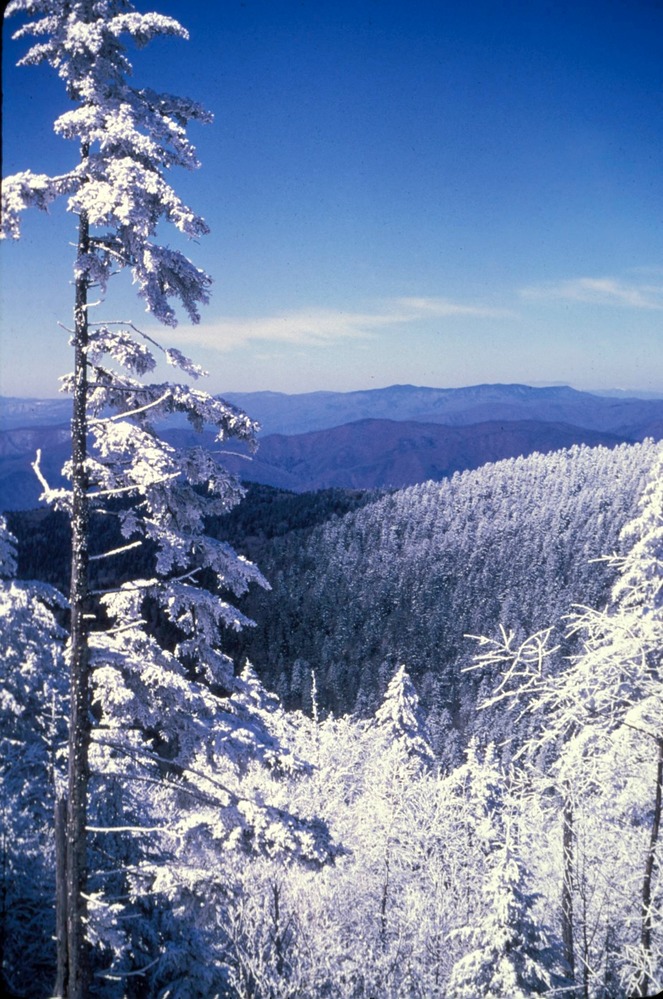
Great Smoky Mountains National Park, located on the border of North Carolina and Tennessee, is best known for its lush forests, mist-covered mountain vistas, and extraordinary biodiversity. It is the most visited national park in the United States, celebrated for its scenic beauty and variety of habitats, from lowland deciduous forests to high-elevation spruce-fir ecosystems. The park is home to over 1,500 species of flowering plants, as well as an array of wildlife, including black bears, white-tailed deer, and a rich variety of bird species. Popular spots like Cades Cove and Clingmans Dome offer spectacular views and opportunities for wildlife observation, while trails such as the Appalachian Trail and Alum Cave Trail attract hikers of all levels. Known for its vibrant wildflower displays in spring, vivid autumn foliage, and frequent mist that gives the Smokies their name, Great Smoky Mountains National Park offers year-round beauty and countless outdoor adventures for visitors seeking to explore the natural splendor of the Appalachian Mountains.
Winter in the Smokies (December-February)
- Snow-Covered Mountains and Serene Winter Landscapes: Winter transforms the Smokies into a tranquil, snow-covered landscape, especially in higher elevations. The snow-dusted peaks and icy waterfalls create a magical atmosphere for winter photography and peaceful reflection.
- Clear Views and Crisp Air: Winter offers some of the clearest views of the mountains, as the humidity drops and the air becomes crisp. Overlooks such as Newfound Gap and Clingmans Dome provide stunning, unobstructed views of the Smokies, ideal for photographers and sightseers.
- Quiet Trails and Fewer Visitors: Winter is the least crowded season, making it ideal for those seeking solitude. Visitors can enjoy peaceful hikes on popular trails, explore quiet backcountry areas, and take in the park’s beauty without the busyness of other seasons.
- Snowshoeing and Cross-Country Skiing: Snowfall in the higher elevations makes winter recreation possible, with opportunities for snowshoeing and cross-country skiing on trails like Clingmans Dome Road (closed to vehicles in winter). Winter provides a unique way to experience the park’s landscapes, with quiet trails and beautiful snow-covered scenery.
8. Mount Rainier National Park
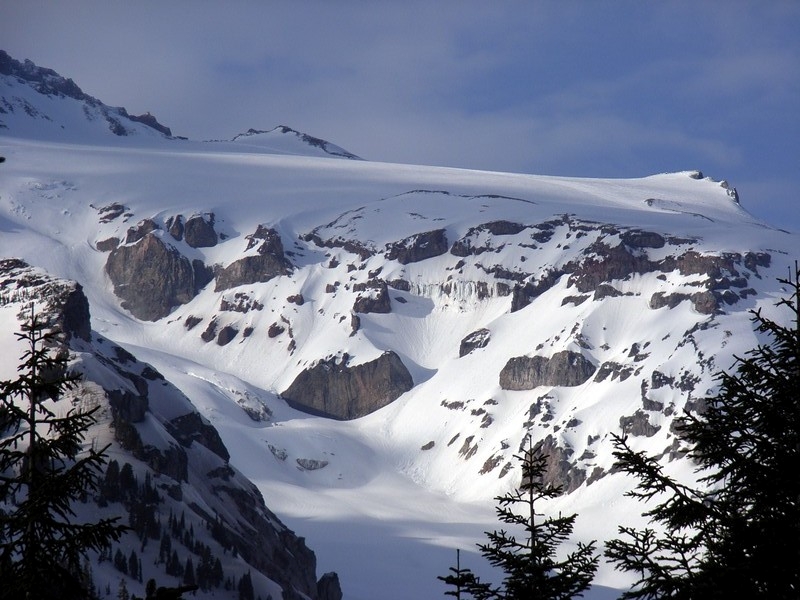
Mount Rainier National Park, located in Washington State, just southeast of Seattle, is best known for its iconic peak, Mount Rainier, an active stratovolcano that rises to 14,411 feet, making it the highest mountain in the contiguous United States. The park is renowned for its stunning alpine scenery, featuring lush wildflower meadows, old-growth forests, and spectacular glaciers, including the extensive Emmons Glacier. Visitors flock to the park to hike its numerous trails, with popular routes like the Skyline Trail offering breathtaking views of the mountain and surrounding landscapes, particularly during the vibrant wildflower bloom in late summer. The park is also a haven for outdoor activities year-round, including mountaineering, skiing, snowshoeing, and wildlife viewing, with opportunities to see deer, elk, and various bird species. With its majestic scenery, diverse ecosystems, and rich recreational opportunities, Mount Rainier National Park is a cherished destination for those seeking to experience the natural beauty of the Pacific Northwest.
Winter in Mount Rainier (December-February)
- Snow-Covered Landscape and Winter Wonderland: Winter blankets Mount Rainier in snow, creating a picturesque winter wonderland. Snow-covered trees, icy waterfalls, and frosty meadows make it one of the most beautiful and unique seasons for photography, offering scenes of Mount Rainier against a pristine white backdrop.
- Snowshoeing, Cross-Country Skiing, and Winter Recreation: Winter is ideal for snowshoeing, cross-country skiing, and sledding. The Paradise area, in particular, is popular for snowshoeing and offers ranger-led snowshoe walks for visitors who want to explore the winter landscape in a safe, guided setting.
- Clear, Crisp Air for Stunning Views: On clear winter days, the crisp air enhances visibility, providing stunning views of Mount Rainier against the blue sky. Winter visitors are often treated to unique photo opportunities, with Mount Rainier standing majestically over the snow-covered landscape.
- Fewer Visitors and Quiet Trails: Winter is the least crowded season, providing a peaceful and serene experience for those seeking solitude. The quiet trails and tranquil surroundings allow visitors to connect deeply with nature, making it a perfect time for reflection and taking in the park’s serene beauty.
9. Acadia National Park
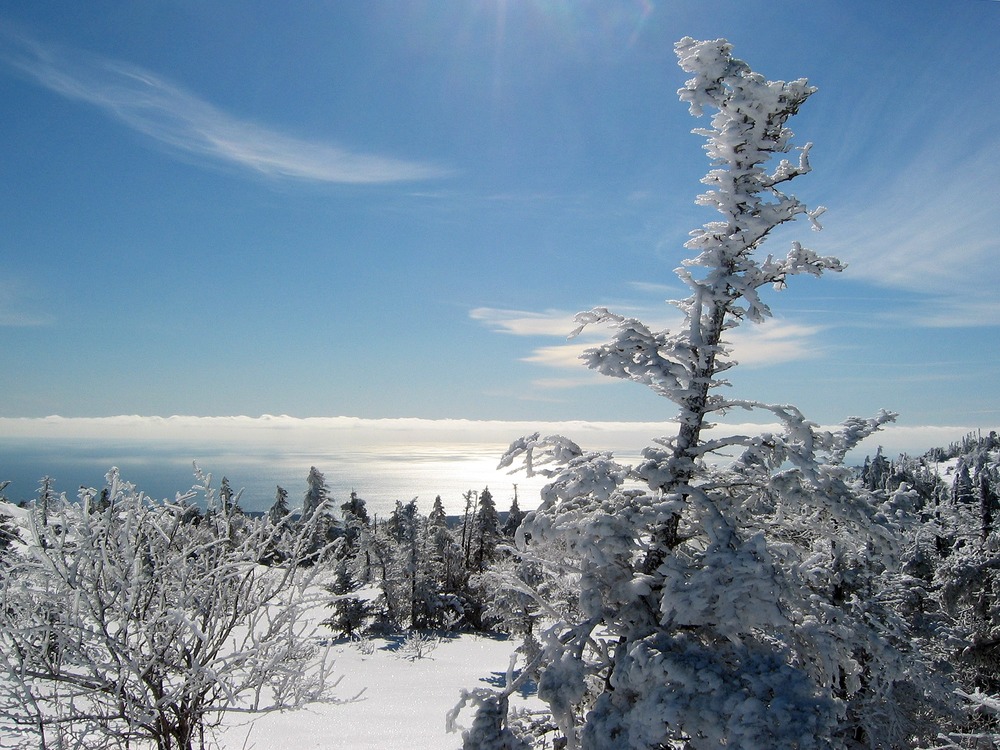
Acadia National Park, located along the rugged coast of Maine on Mount Desert Island and surrounding areas, is best known for its stunning coastal scenery, granite peaks, and scenic drives. The park’s dramatic landscape includes rocky shorelines, dense forests, and the highest point on the U.S. Atlantic coast, Cadillac Mountain, where visitors can catch the first sunrise in the United States from October to March. Acadia’s picturesque trails, like the Precipice Trail and Jordan Pond Path, attract hikers with sweeping ocean views and diverse terrains, from mountain summits to serene ponds. The 27-mile Park Loop Road offers a beautiful drive with access to iconic spots such as Sand Beach, Thunder Hole, and Otter Cliffs. Acadia is also known for its rich wildlife, including white-tailed deer, peregrine falcons, and seals, as well as vibrant fall foliage that draws visitors in autumn. With its blend of coastal beauty, recreational opportunities, and panoramic vistas, Acadia National Park is a beloved destination for those looking to experience New England’s natural charm.
Winter in Acadia (December-February)
- Snow-Covered Landscapes and Unique Scenery: Winter brings a serene beauty to Acadia, with snow blanketing the park’s mountains, trees, and coastline. The sight of snow-dusted peaks and frozen lakes creates a magical winter wonderland that’s ideal for photography and quiet reflection.
- Winter Recreation Opportunities: Winter visitors can enjoy cross-country skiing, snowshoeing, and even winter hiking on designated trails. Carriage roads are particularly popular for snowshoeing and skiing, allowing visitors to explore Acadia’s winter landscapes in a peaceful setting.
- Fewer Visitors and a Quiet, Contemplative Experience: Winter is the least crowded season, perfect for those seeking solitude. The quiet trails, snowy vistas, and serene forests offer a contemplative experience that allows visitors to connect with the natural beauty of Acadia in an intimate way.
- Clear, Crisp Skies for Stargazing: Winter’s clear air and early sunsets make it a great season for stargazing. With minimal light pollution, Acadia’s night skies reveal breathtaking views of stars, constellations, and occasionally the Northern Lights, creating an awe-inspiring nighttime experience.
10. Everglades National Park
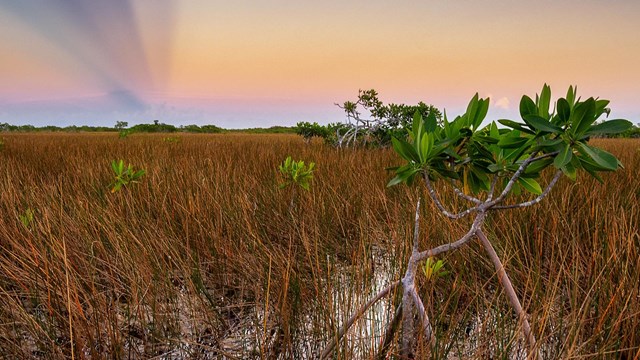
Everglades National Park, located in southern Florida, is best known for its vast and unique subtropical wetlands, home to a remarkable diversity of plant and animal species. As the largest tropical wilderness of its kind in the United States, the Everglades is a World Heritage Site and International Biosphere Reserve, covering over 1.5 million acres of sawgrass marshes, mangrove forests, and coastal estuaries. This ecosystem is famous for its rich wildlife, including American alligators, crocodiles, manatees, and a variety of bird species, such as herons, egrets, and roseate spoonbills. Visitors can explore the park by boat, kayak, or on foot through boardwalk trails, such as the Anhinga Trail, which offers some of the best wildlife viewing. Known as the “River of Grass,” Everglades National Park plays a vital role in water flow and biodiversity, making it an essential sanctuary for Florida’s natural heritage and a fascinating destination for ecotourism and nature enthusiasts.
Winter in the Everglades (December-February)
- Comfortable Temperatures and Cool Breezes: Winter is the peak season for visiting the Everglades, with temperatures ranging from 60-75°F (15-24°C). The mild, dry weather is perfect for hiking, biking, and enjoying outdoor activities without the intense humidity and heat of summer.
- Dry Season Concentrates Wildlife: Winter is part of the Everglades’ dry season, which draws animals to the remaining water sources, making it easier to spot alligators, turtles, and wading birds. Trails like Shark Valley and Anhinga Trail provide excellent viewing areas for observing wildlife close up.
- Peak Birdwatching Season: Winter is the best season for birdwatching, with a wide variety of migratory species, including white pelicans, cormorants, and wood storks, arriving from northern climates. Birdwatchers can explore the park’s ponds and marshes to see diverse species congregating in large numbers.
- Ranger-Led Programs and Educational Opportunities: Winter is the peak season for ranger-led programs, including wildlife talks, guided walks, and boat tours. These programs provide valuable insights into the park’s ecosystems and history, enhancing the experience for visitors of all ages.
Winter brings a unique magic to our national parks, showcasing breathtaking landscapes and offering a peaceful, crowd-free way to experience the great outdoors. Whether you’re drawn to snowy peaks, frosty forests, or warmer wildlife havens, each park on our list offers something special for winter explorers. As you plan your next cold-season adventure, remember to check weather conditions, park accessibility, and gear up properly for a safe and memorable visit. Embrace the quiet beauty and exhilarating activities that only winter can offer, and let these parks inspire you to explore nature’s hidden wonders in the chill of the season. Happy winter travels!
Want to dive deeper into exploring America’s national parks in winter? Join our VIP Club for exclusive access to our Resource Library, where you can enjoy our complete America’s National Parks in Winter book! Packed with information and beautiful photography, this book is your ultimate companion for planning unforgettable winter adventures. Sign up today and start exploring the wonders of winter in our national parks!
